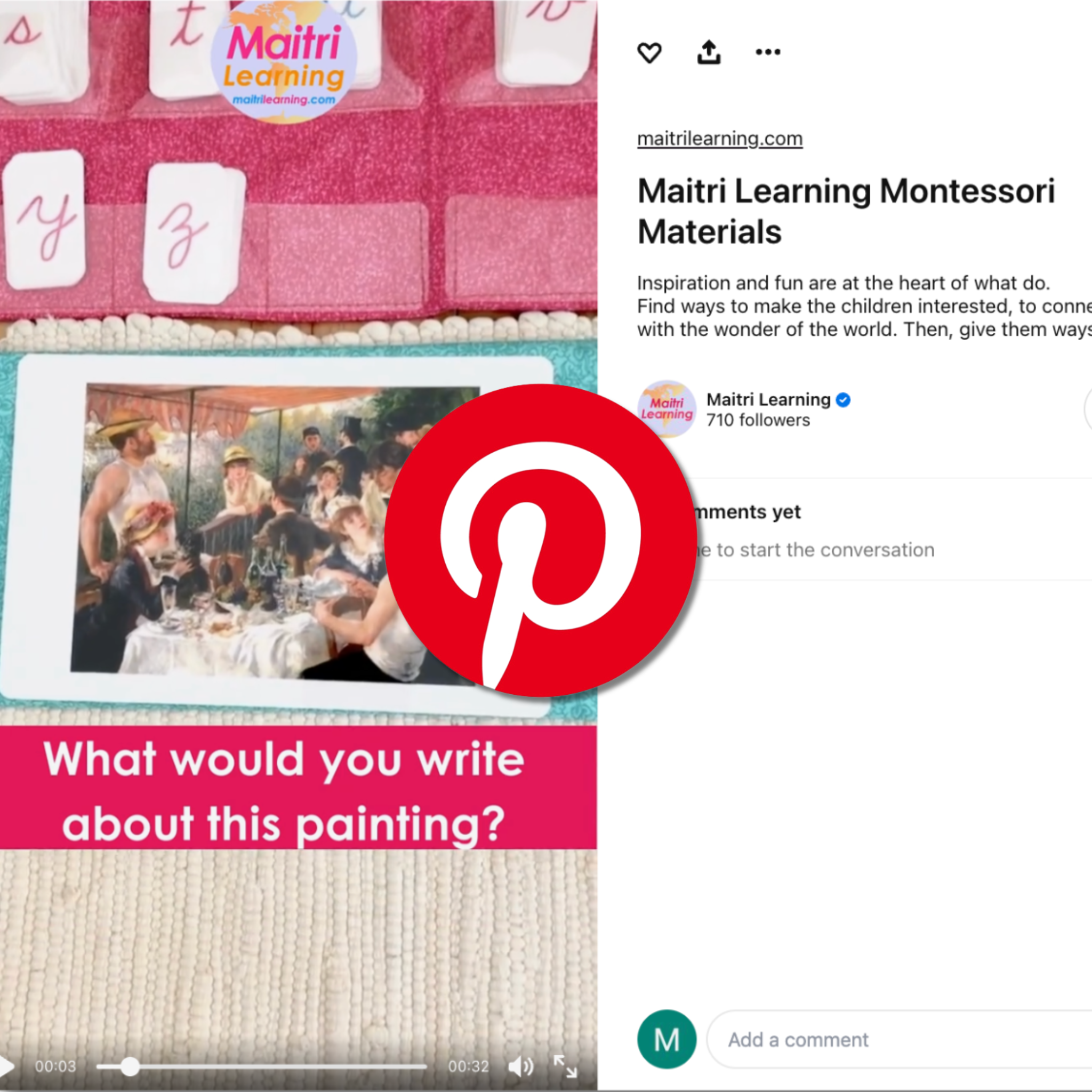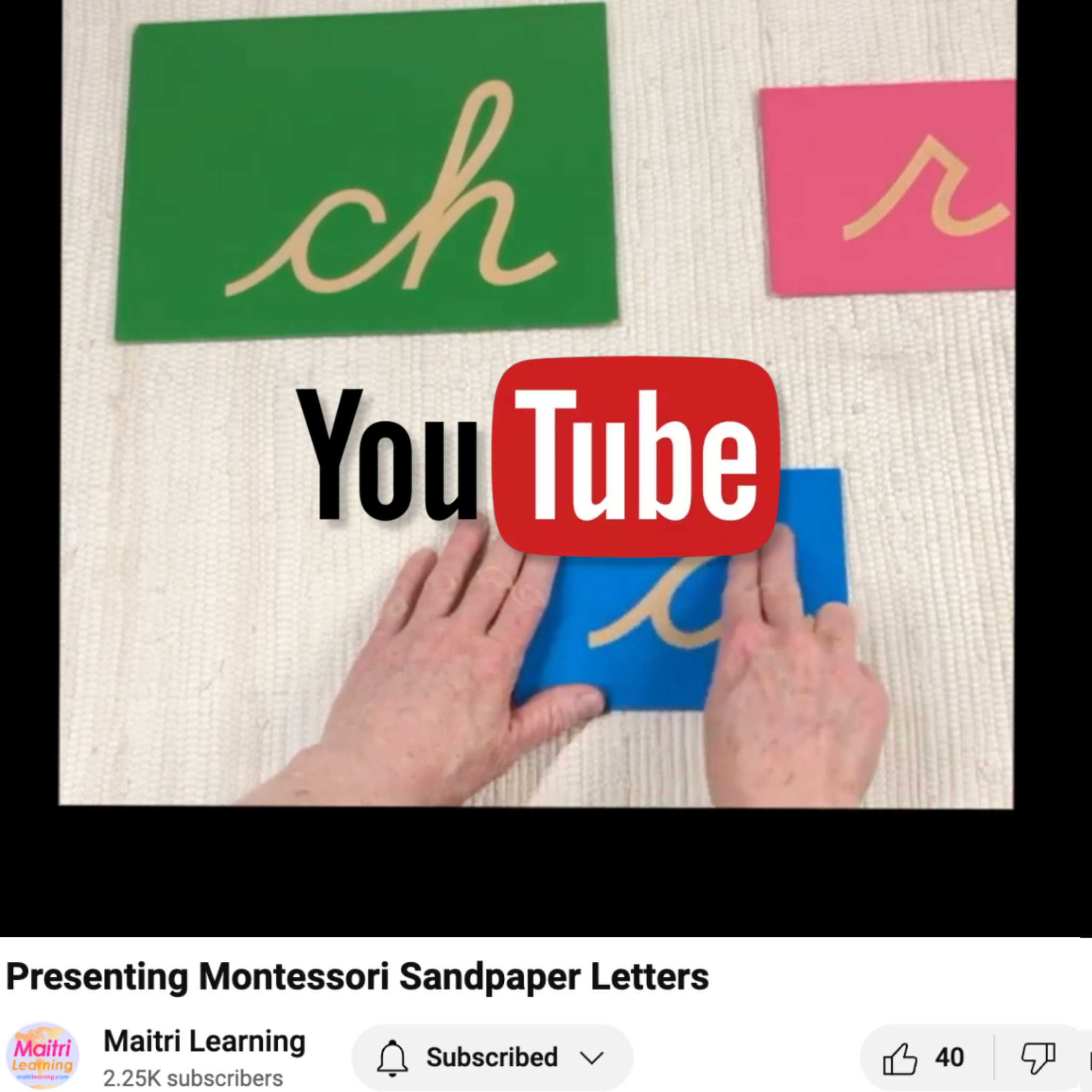Developing the attention span via polishing
Parents often ask Montessori teachers why their children are learning so much about cleaning at school. Their children are learning how to wash dishes, sweep the floor, dust, and even polish silver. Can't the school afford to hire their own cleaning staff?
The answer has nothing to do with keeping the classroom clean. In fact, teachers often have to go back after school and "re-clean" what the children have cleaned. The reason we teach them these "practical life" activities is all about aiding the child's development.
A mom I know on Instagram (big shout out to @montessoriinmotion) posted a video of her daughter that illustrates some of the benefits of practical life activities. It's just over one-minute long and is so rich in things to notice that I asked her permission to write about it here. Watch the video on your own first and then read on (and yes, she is sporting the matching Maitri Learning blue flower apron and mat).
Focused Attention
In the first few seconds, you can see that she couldn't care less about the neighbor's barking dog; she is very focused on her activity. She begins by setting up what she'll need: the object to be polished (the turtle), the glass bowl (which will hold the polish), and the polish. While she is doing part of this, her eyes are fixed on the contents of the blue basket. She does not look at where she is placing the glass bowl. Why does this matter? It means that she has already learned how to place an object down with her hand (maintaining proprioceptive control) while her visual attention is focused elsewhere. So, when you think that where a child's eyes are looking tells you what they are paying attention to, stop and think again!
Handedness
Did you notice that she uses her left hand to pick up and lay out each of these items? But when she gets to the polish, she starts opening it using her right hand. She reconsiders, possibly remembering that she doesn't need to open it yet (self-correction), and places it down. Next, she switches to her right hand to take out the remaining items she'll need.
When you see children choosing hands to work with at this age, you may see them switch from left to right or you may see them strongly dominant already for the right- or left-hand. You don't have to worry about it. When you present a lesson to them, just use your dominant hand but if they struggle with that hand, simply say, "Maybe it will work better with your other hand. You can try it."
Pausing
Once she has the polish on the mat, she pauses to organize her thinking. This pause is often a tricky spot for adults. We want to step in and make sure they know what to do next. But it is in the pause that so much great development happens (memory consolidation, toggling the default mode network, etc.). So, one of our biggest jobs is to restrain ourselves and give the child time to figure it out.
Sensory Learning
Now she uses her right hand to take out the sponge, cotton swab, and buffing cloth. As she takes out each one, she touches it an extra time as if to receive physical confirmation of what the object is. In neuroscience speak, we call this haptic engagement. She pushes down on the sponge and feels its spring. She uses the pincer grip to precisely place the cotton swab. She uses her whole hand to pat the buffing cloth. Each of these movements is different based on the properties of the object she touches. They also mirror the movements she will use later when putting each object to use.
(As an aside, when I see her haptic engagement and her ability to follow logical steps/procedures, I am thinking she might be quite interested in the sandpaper letters. To prepare her for that work, this may be the right time to start playing some sound games. After a few weeks of sound games, you'll be able to introduce the sandpaper letters.)
Executive Function Development
Okay, back to the polishing work. After patting the buffing cloth, her eyes scan the basket until she finds the thing she needs next--the polish. I love how she nods to herself to validate that yes, now it is time to open the polish! So when we saw her hesitating with the polish when she first took it out, we actually saw her exhibiting inhibitory control: she stopped herself from opening it before it was time to open it. Inhibitory control is a key foundation for higher executive functions. You can google "marshmallow test" if you want to see many examples of young children flexing their inhibitory control abilities.
Now she uses her left hand to hold the polish bottle and her right hand to remove the top and squeeze the dropper (again using the pincer grip.) But when she is placing polish into the dish, you can just see that her eyes are scanning back and forth between the dropper and the dish. This means that her eyes are already moving ahead to the next step of confirming that she has the right amount of polish. Again, this is evidence of her developing executive function ability to plan ahead.
Concentration Overcomes Distraction
Right at about 50 seconds in, her brother comes over and starts talking with her mom about how they might possibly make the paint he wants to use to paint a baseball diamond on the front lawn. First of all, that is an utterly gorgeous thought process by her brother! He is absolutely ingenious in thinking about the chemical properties of paint. Second, his conversation does not phase his sister the tiniest bit. Her concentration remains 100% on her polishing activity; even when her eyes glance away. So when you hear someone say that two-year-olds are easily distracted, question if that is really true.
Refined Motor Skills
Right after she applies the polish to the turtle's back, the turtle spins. This suggests that she used a little bit too much force. The natural consequence is that the turtle spins around. She then moves in for a very close look and we don't see the turtle spin again suggesting that she is using a lighter touch. We just saw a natural consequence lead to the refinement of fine motor skills!
The need for natural consequences is one of the reasons Montessori environments use items that might break if they are misused, like real glasses and dishes (not plastic or melamine). We expect things to break if they are handled roughly. We always model very careful use but the child might not pick up on this right away. So, when an object breaks because it is mishandled, the child realizes that they need to actually pay attention to what their hand is doing when they hold fragile items. I wish we could do a research study on this point, but in my experience, most children only break one or two things before they adapt and refine. Children who are always given plastic miss this opportunity when the mind is ripe for it.
Attention to Detail
Okay, let's get back to polishing. When she finishes applying the polish, she holds on to the cotton swab in her right hand and picks up the sponge with her left. She dabs some polish off of the turtle with the sponge but then she uses the sponge to clean off the cotton swab. Only after the swab is wiped off does she place it on the mat. She sets the sponge down then but picks it up again when she notices there is still a bit more polish to wipe off. Once the sponge finally goes to the mat, she uses her left finger to rub the turtle's back. It's not clear if she is rubbing off an extra bit of polish or verifying that the polish is off. In either case, she is using her finger to attend to this tiny detail.
My husband is always saying he wished his undergraduate chemistry students paid better attention to details in the lab. Maybe they needed to polish more when they were little.
Scaffold/Control of Error
Again, we have a pause where she scans the mat to determine her next step. The order that the materials are lain out on the mat acts as a scaffold; the order helps her to figure out what is coming next. She looks until she finds what she needs. In Montessori we call this a built-in control of error. It means the adult doesn't need to step in at all while the child is concentrating, the materials themselves will guide the child. This is essential because it allows her to keep working without interruption. That is what is strengthening the neural networks in her attention system. So again, we grown-ups need to step back and allow the child the opportunity to process, think, and choose.
Strengthening the Hand
Now comes the buffing. She starts to rub up a shine with her right hand only. But, this is no one-handed moment! She quickly brings in her left hand to stabilize the turtle so she can apply more force in her buffing. This variable application of strength not only refines her motor skills (as noted above), but also increases her muscular strength and control. And, of course, it creates a really nice shine!
Self Esteem
The very last thing the video shows us is her enormous smile when she has reached the moment of completion. She is satisfied and happy with what she has accomplished. This, I believe, is where self esteem and self confidence truly come from. Hearing someone else tell us we did a good job is never as deeply satisfying as witnessing our own good work come to fruition.
So, there you have it, eleven ways in which a Montessori practical life activity contribute to the optimal development of the young child. The next time you wonder if you should engage your child in helping out around the house, think back on this. When we do work together with a child, prepare them to work independently, and then give them the freedom to work on their own, we are helping them immeasurably.
What do you think? Please post your comments below to continue the conversation. It takes a village!








1 comment
That was a delightful video and I enjoyed seeing the child’s concentration and satisfaction. Your explanation of the thought processes really opened my eyes, though. I learned so much! Thank you! I think I’ll offer my toddler a polishing exercise soon…
Holly
Leave a comment
This site is protected by hCaptcha and the hCaptcha Privacy Policy and Terms of Service apply.